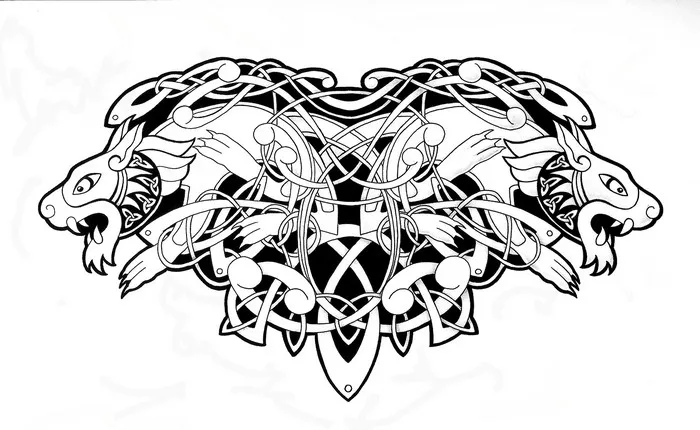Tattooing, an art form dating back thousands of years, has fascinated cultures around the world. From ancient Egypt to Polynesia, tattoos have held various meanings and significance. Among these cultures were the Celts, a diverse group of tribal societies that thrived in Europe over two millennia ago. While much is known about their intricate artwork and symbolism, the question remains: Did Celtic pagans have tattoos?
To uncover the truth behind this intriguing inquiry, we must delve into the archaeological findings, historical accounts, and cultural practices of the ancient Celts. By examining these sources, we can gain insight into the role of tattooing within Celtic society and decipher whether it was indeed a common practice among the pagan Celts.
Understanding Celtic Culture and Beliefs
Before delving into the evidence of Celtic tattooing, it is essential to understand the broader context of Celtic culture and beliefs. The Celts were a collection of tribal societies inhabiting vast regions of Europe, including modern-day Ireland, Scotland, Wales, France, and Germany, among others. They were renowned for their artistic skills, craftsmanship, and rich oral traditions.
Celtic society was deeply rooted in nature and spirituality, with beliefs centered around animism, the worship of nature spirits, and reverence for deities associated with natural elements such as forests, rivers, and mountains. Their religious practices were complex, often involving rituals, sacrifices, and ceremonies conducted by druids, the spiritual leaders of Celtic communities.
The Archaeological Evidence
One of the primary sources of evidence regarding Celtic tattooing comes from archaeological discoveries. Over the years, researchers have unearthed numerous artifacts adorned with intricate designs similar to those found in Celtic artwork. These artifacts include pottery, metalwork, and personal items such as combs and mirrors.
Among the most notable discoveries are the preserved remains of ancient Celts, particularly those found in burial sites and peat bogs. These remarkably well-preserved bodies provide invaluable insights into Celtic appearance and adornment practices. While evidence of tattooing on these remains is scarce, other forms of body modification, such as scarification and dental ornamentation, have been identified.
Interpreting Celtic Artwork
Another avenue for exploring Celtic tattooing is through the analysis of their artwork and symbolism. Celtic art is characterized by intricate patterns, geometric shapes, and stylized representations of animals, plants, and mythical creatures. These motifs adorned various objects, including jewelry, weapons, and religious artifacts.
Some scholars argue that the motifs found in Celtic artwork may have served as inspiration for tattoos. The repetitive patterns and symbolic imagery suggest a deep cultural significance associated with these designs. Additionally, the placement of these motifs on objects such as swords and shields implies a form of personal or tribal identity, which could extend to the adornment of the body through tattooing.
Historical Accounts and Literary Sources
While direct evidence of Celtic tattooing is limited, historical accounts and literary sources offer valuable insights into their cultural practices. Greek and Roman writers, such as Julius Caesar and Strabo, documented their encounters with Celtic tribes during military campaigns and trade expeditions.
Caesar, in his work “Commentarii de Bello Gallico” (Commentaries on the Gallic War), describes the Celts as fierce warriors adorned with elaborate designs painted or drawn on their bodies. While Caesar’s accounts primarily focus on face painting rather than tattooing, they suggest a tradition of decorative body adornment among the Celtic peoples.
Similarly, the Irish mythological cycles, such as the Ulster Cycle and the Fenian Cycle, contain references to warriors and heroes bearing distinctive markings or brands. Although these references are not explicit evidence of tattooing, they provide tantalizing glimpses into the possibility of tattoo culture within Celtic society.
Contemporary Perspectives and Revival
In modern times, there has been a resurgence of interest in Celtic culture and tattooing. Contemporary Celtic-inspired tattoos often incorporate traditional motifs and designs, paying homage to the rich artistic heritage of the ancient Celts. While these tattoos may not be authentic representations of historical practices, they serve as a testament to the enduring legacy of Celtic art and symbolism.
Additionally, ongoing research and archaeological excavations continue to shed light on the mysteries of Celtic tattooing. Advances in scientific techniques, such as DNA analysis and microscopy, offer new avenues for studying ancient remains and artifacts, potentially revealing traces of tattoo pigments or patterns.
Conclusion
In conclusion, the question of whether Celtic pagans had tattoos remains a subject of debate and speculation among scholars and enthusiasts alike. While direct evidence of tattooing is scarce, the archaeological findings, artistic representations, and historical accounts provide tantalizing clues to suggest the existence of tattoo culture within Celtic society.
The intricate artwork, symbolic motifs, and cultural practices of the ancient Celts hint at a tradition of body adornment that may have included tattooing. While we may never uncover definitive proof of Celtic tattooing, the ongoing exploration of Celtic culture and heritage continues to captivate our imagination and deepen our understanding of this fascinating civilization.

